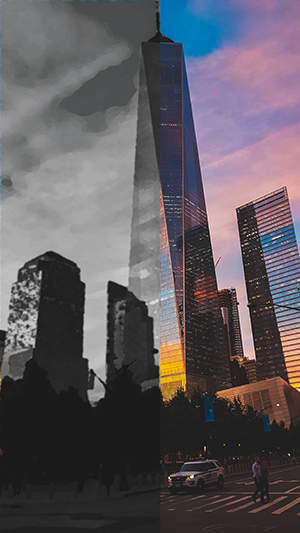Mosaic, Melting Pot and AI

Will artificial intelligence flatten what makes cultures unique?
As the Senior Manager of Communications and Technology, I am intrigued by the areas where technology protrudes into culture. Like you, I have been beset by newsletters, social posts, articles and podcasts about AI. Does AI support equity? I think that AI and algorithms threaten to flatten culture, and doing so will weaken our society and further promote inequity.
Mosaic or Melting Pot
What is the goal of equity work?
It sounds obvious but if you gathered descriptions of what an “equitable society” would look like in practice, I suspect you would gather a broad range of descriptions and not all could co-exist. Even in our small organization, Inspiring Communities has experienced the challenge of coming to a common understanding of what equity is, and who are “equity-deserving groups.”
Consider the different approaches to multiculturalism taken in our settler nations of Canada and the United States. At least, the theory—the effectiveness of these approaches is a separate discussion!
The book The Canadian Mosaic was written by John Murray Gibbon in 1938. The mosaic idea — that each cultural group would retain a distinct identity and still contribute to the nation — would shape our country’s immigration and multiculturalism policy in the last century’s latter half. This idea of distinct cultures echoes the strength of the French population in Quebec and throughout other parts of the country. 1

In contrast, the United States has a more assimilationist approach, the melting pot: in theory, everyone comes and becomes American. One big happy family! (Your mileage may vary).
Drawing in from a national scope to a community lens, it is easy to see the benefits to the mosaic – the opportunity to learn from each other, to sample new foods, to experience new celebrations and rituals. New ideas, innovations and businesses strengthen our economy. Many of us prize this more cosmopolitan experience, which offers the rewards of travel without having to leave home. As Steve Earle sings (ironically about New York—an American city), “Living in the city of immigrants, I don’t have to go traveling. Open my door and the world walks in.”2
At the same time as we enjoy experiencing the world this way, nearly every Nova Scotian has heard a version of “they moved here, why can’t they just talk like / act like / be like us?”
This sentiment is not a singular stop on a right to left single-plane political spectrum. Sure, sometimes it stems from xenophobia or racism. But sometimes it means, “why does it appear that the women of this ethnic or religious group are still oppressed, despite being in our free country?” Or, “Why are these two nationalities that have long been at war not able to lay down their disagreements now that they are on neutral territory?” Or, “Why do students from this part of the world seem extra reluctant to ask questions in class?” These questions are often resolved by building relationships.
Assimilation versus Individualism
Because the USA is often noted as a very individualist society, it is interesting that a Hofstede comparison on Individualism versus Collectivism shows that Canada currently has a higher individualism score than the US.3 The melting pot approach sounds like it should result in a more collectivist mindset, but America has a deep cultural bias and extreme hatred of Communism (dating back to the 1930s if not earlier), which perhaps provides a counter balance. Canada having the higher score surprised me. It is tempting to think that Canada being a collection of distinct cultures would require a more collective orientation to get along, and also that the collectivism attributes of some immigrants should filter out into society. For a close examination of Canada’s Geert Hofstede score (which may be a bit out of date) check this site.
Even with the risks and challenges, I prefer the mosaic approach, in experience and in theory. I would argue the Inspiring Communities’ vision of equitable thriving communities aligns with this approach: respect and welcome each cultural micro-community, and be open to receive the strengths and assets they bring to the whole.
The melting pot is an assimilationist practice. Assimilation has long been a terror element added to science fiction – think of the Borg on Star Trek or the Cybermen on Doctor Who. Both fictional villains reflect a primal fear of loss of self, or assimilation. It is worth noting how the fear of assimilation and losing our individual selves is often augmented by being shown alongside scary technology.

A Detour into Bible Stories
But before we get fully into technology and the future, allow me a brief digression – consider the Biblical story of the Tower of Babel. What does the story mean? In Sunday school, we were taught that people tried to build a tower to reach God and because of their pride, God introduced confusion in the form of many languages, and this is where the different cultures of the world came from. If you, like me, think that God sounded like a mean teacher in this story, I invite you to consider an alternative interpretation. What if Babel is about resisting the monolith, whether that is a singular empire or a fully assimilated culture? If you subscribe to the Bible teaching that God granted humans free will, then surely Babel points to the idea that to achieve ‘heaven’ whatever that might look like, we must learn to work together despite our differences. Diverse communities are stronger. Systems that depend on diverse and distributed inputs are more robust.
Bible scholars are, of course, welcome to drop into the comments and disagree or correct me.
An Artificial Melting Pot
Our cybersecurity trainer recently made the point that our IT system, comprising a dog’s breakfast of different devices since we mostly use our own, is actually harder to hack because of this diversity.4 The exploitable weaknesses of an Android phone, ASUS laptop, Apple tablet and Windows Surface are all going to be different. Again, diverse systems are stronger.
Artificial Intelligence (AI) is the current inescapable Hot Tech Trend™. All social media platforms are awash in posts either describing how to harness AI in your business or advertising training seminars on this topic. Probably a high percentage of these posts are themselves crafted by AI, which begs the question around what “social” means, and if that includes bots talking to bots.
The unintended biases introduced into AI and similar tools by programmers is a well-documented concern, and yet the Internet runneth over with articles describing how your organization can harness AI for more equitable outcomes, How Artificial Intelligence Can Improve Diversity, Equity, Inclusion and Accessibility Efforts, and Harnessing AI to improve the lives and well-being of vulnerable communities. These are posted by sources of varying relevance and credibility, including consultants Project Evident, the US Department of Commerce and the Bill and Melinda Gates Foundation. Gender and the Economy has a particularly good critical analysis, An Equity Lens on Artificial Intelligence.

One solution to making AI more equitable is finding a wider, more diverse array of materials to train the AI tool on. Setting aside for a moment the massive concerns this raises about intellectual property,5 consider how this might result in an AI melting pot.
If AI learns from and expands its understanding based on all the information it reviews, and lacks a fundamental ‘self’ to provide a point of view on this information; and if AI is heading toward ubiquity in our online lives, as it certainly seems to be now; and finally, if we accept (and this is definitely my experience) that our culture in Canada at this point in time is shaped in large part by our online experience; then we are headed toward a neutral beige future, a melting pot pouring out cement.
All of the colour and vibrancy that the image of “mosaic” brings up is going to go into that blender of assimilation and come out the other end… boring. Safe? Middle of the road. The non-colour of blended recycled paint. Go ask AI for the Bhagavad Gita rewritten in the style of Keats, then rewritten again as Ernest Hemingway. Now turn it into a James Gunn film. Now a restaurant menu. Is it still the Bhagavad Gita?
Algorithms offer shortcuts to serve us things “we may find interesting” on many platforms: Google, Youtube, Spotify, X, Facebook. But do the machines really know us, in our full complexity? Or do they know an aggregate avatar of the last 200 things we looked at, which fits a profile of roughly 18% of the population who have indicated similar interests?6 There are some good examinations of how algorithms work to influence and affect culture, including the 2020 New York Times podcast Rabbit Hole and the new book Filterworld: How Algorithms Flattened Culture by Kyle Chayka. The latter asks the question, “What happens when shareability supersedes messiness, innovation, and creativity—the qualities that make us human?” Technology is about smoothing out the outliers, the ragged edges of the statistical graphs… the parts where we find innovation, glitches, uniqueness.
Let’s not let that happen. The more appreciation we individually develop now for the people and cultures around us, the more we seek to understand and be curious, the more value those individual cultures will be assigned. And value is what matters – that will move the programmers to figure out how to accommodate a mosaic and avoid the flattening, or the melting.
With AI more and more used in social scenarios like communications, hiring employees, and recommending criminal sentencing, we need AI that can see colour. AI is often celebrated as a way to avoid emotional human biases. That is desirable, but only in that “equity-versus-equality” way in which “fair” treatment considers historical injustices and current biased systems.
What are your thoughts on AI? What are the promises or threats that speak to you? We welcome your thoughts in the comments.
Footnotes:
- That this approach of embracing distinct culture was not applied to our relationship with the original peoples on this land is one of our great failings. Also, that a society that set out to “erase the Indian” wound up with a mosaic approach is kind of mind-blowing.
- From 2007’s Washington Square Serenade. Check out this live version: https://www.youtube.com/watch?v=75H8J6lURZc
- Canada’s score is 72 vs the US’s 60. For comparison, the traditionally more collectivist China scores 43.
- Also harder to service! But you know, you take the raisins with the jellybeans.
- “Massive” isn’t hyperbolic enough. GIANT FLASHING RED FLAGS around IP.
- These numbers were completely made up inside my non-AI brain and probably do not represent any accurate algorithm information.
Photo credits:
- Group photo by Jopwell, stylized by me
- Building photo by Mihai Vlasceanu, stylized by me
- Computer photo by Oladimeji Ajegbile, stylized by me
Share this:
Comments are closed